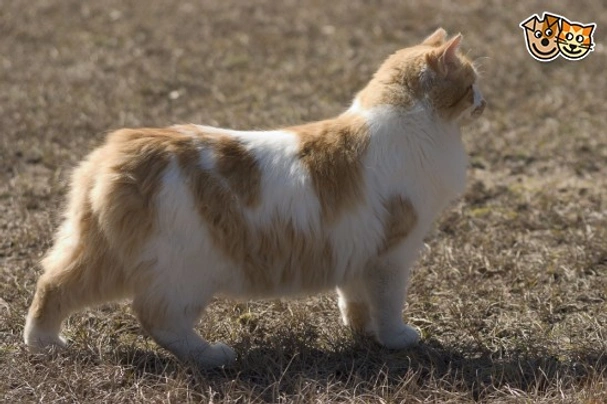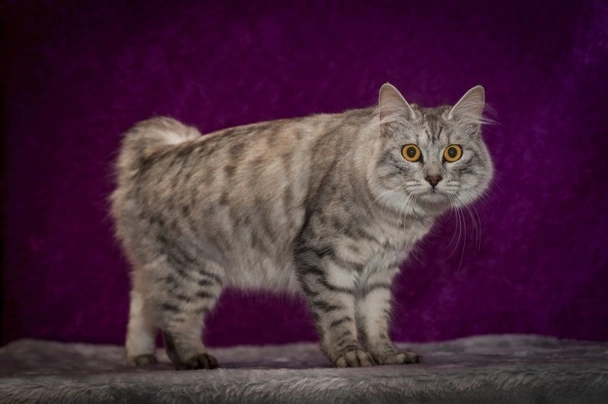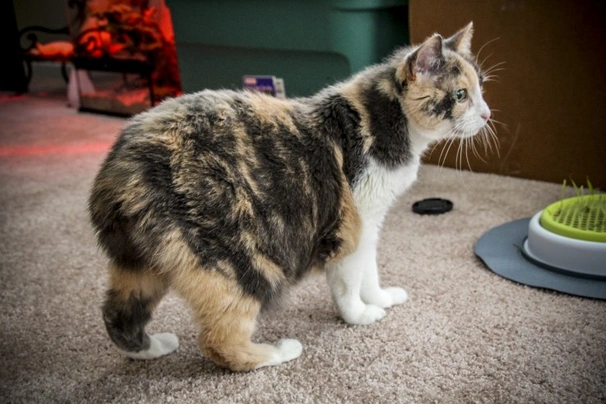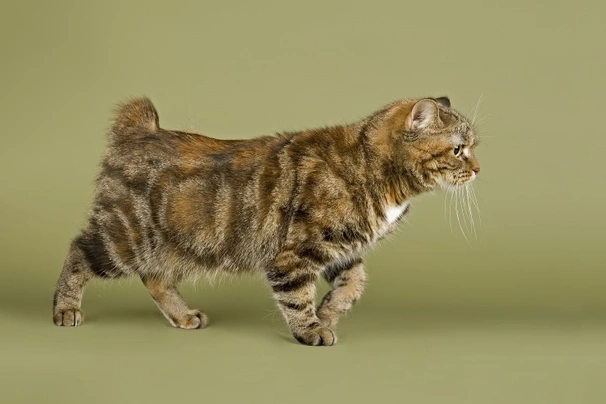Manx
Introduction of the Manx
The Manx is native to the Isle of Man where they have always been highly prized for being extremely good mousers. The breed is quite unique in that cats are born with short or no tails which is a naturally occurring mutation. They also have a quite unique gait which is another trait that sets them apart from other breeds. The Manx is the island's national symbol and have become a popular companion and family pet both in the UK and elsewhere in the world thanks to their lovely natures and unique looks.
History of the Manx
The Manx is an old breed that hails from the Isle of Man where they have always been highly prized for their ratting skills. They were highly prized as ship's cats because they were so good at controlling vermin. The fact they have no tail or very little tail is a naturally occurring mutation in the breed. Legend has it that the cats were bought to the island by visiting boats and that they are in fact descendants of cats that hailed from the mainland although the actual origins of these mainland cats remains a bit of a mystery.
At one time their name was spelt differently being "Manks" but the spelling was subsequently changed to Manx. When a Manx is crossed with other breeds the gene responsible for the lack of tail is so dominant that litters are often born without or with very little tail as a result of the mating. At one time many people used to believe that when other cats got close to a Manx it would cause them to produce tailless kittens. Another legend tells of how cats were crossed with rabbits which is why they were tailless and why they hop much like rabbits do.
Over the years the Manx has earned the reputation of being a lovely companion and family pet. As a real bonus they are natural hunters and expert mousers. As such they thrive in a country environment where they can indulge their natural instincts. Today these lovely tailless cats have found their way into the hearts and homes of many people not only in the UK but elsewhere in the world too.
Appearance of the Manx
A lot of Manx cats only have extremely short tails although some only have a stump and others have no tail at all which is the main physical characteristic of the breed. However they have long strong back legs which also sets them apart from other breeds. The Manx also has a charmingly domed head that adds to their overall endearing appearance. The longhaired Manx is known as the Cymric and in some countries they are considered to be a separate breed in its own right.
As previously mentioned the Manx has a domed head and they boast having prominent cheeks. Their noses are straight and broad being moderately long and without a break. Their muzzles are powerful and they have firm chins and a nice even bite. Their ears are quite large and they sit high on a cat's head being slightly angled outwards. They are wider and open at the base but taper to a rounded narrow tip. The Manx has round large eyes that match their coat colour.
They have compact solid bodies with nice broad chests and short backs that finish nicely on well-defined rounded rumps which are a little higher than a cat's shoulders. Their legs are well developed with the front ones being shorter than their back legs. Their hind legs are powerful and boast having deep thighs. Cats without tails have rounded rumps with no sign of a tail bone or cartilage.
When it comes to their coat the Manx boasts having a longer top coat and a shorter extremely dense undercoat. In the breed the quality of a cat's double coat is more important than their markings or colours. With this said the only colour that is not acceptable under the GCCF breed standard is as follows:
Siamese
Temperament of the Manx
The Manx is known to be a gregarious social and very affectionate cat although they tend to be quite shy around strangers. They are also extremely intelligent and love nothing more than to play much like their canine counterparts. They also behave a lot like their wild cousins in that they like to be around other cats and often form a "pride". Manx are not known to be as territorial as other breeds and will do their level best to avoid any sort of confrontation or conflict when they encounter other cats.
The Manx likes to carry toys around and is good at using their paws to open doors cabinets so they can get inside. They are gentle cats by nature and love being with their families although some cats tend to form a stronger bond with one person which is usually the person who feeds and takes the most care of them. They have quite a shrill voice and known to be quite talkative when the mood takes them.
As previously mentioned the Manx boasts having very powerful back legs and are able to leap forward much like a rabbit. They love jumping up high and are capable of reaching great heights. They also mature very slowly and therefore retain many of their kitten-like traits longer than other breeds which makes them great fun to have around and why they have fast become so popular as companions and family pets.
Intelligence / Trainability of the Manx
The Manx is an extremely smart cat and one that needs to be kept occupied in between their cat naps that is. Because they are so clever they learn things quickly which includes figuring out puzzles and can be taught to do many things using positive reinforcement which make it much like training a dog. They thrive in a country environment where it's safe for them to explore the great outdoors but they don't do that well when kept as indoor cats unless they are given enough stimulation to keep them happy bearing in mind that "hunting" is a trait that's deeply embedded in a Manx's psyche.
Children and other
The Manx with their outgoing affectionate personalities are the perfect choice for families with children and they make wonderful companions. They are quick on their feet and therefore know when to get out of the reach of smaller children when they get too boisterous or loud and they typically do so by leaping to safety up high. However care has to be taken when very young children are around cats and any interaction should always be well supervised to make sure things stay nice and calm. Children need to be taught how to behave around cats and when to leave them alone.
The Manx also gets on well with dogs especially if they have grown up together in the same household. However care has to be taken when introducing a Manx to a dog they don't already know just in case the dog does not get on with their feline counterparts. They are also known to get on with other cats preferring to avoid any sort of confrontation. The Manx is a social cat by nature and generally get on with other animals. However it's always wiser to keep a close eye on any cat when they are around smaller pets just in case bearing in mind that the Manx boasts being an extremely adept hunter.
Health of the Manx
The average life expectancy of a Manx is between 8 and 14 years when properly cared for and fed an appropriate good quality diet to suit their ages.
The Manx is known to suffer from a few hereditary health issues which are worth knowing about if you are planning share your home with one of these affectionate and loyal cats. The conditions that seem to affect the breed the most include the following:
- Manx Syndrome - Breeders must show care when breeding the Manx always selecting the right cats for a breeding programme
- Sacrococcygeal Dysgenesis
- Megacolon
- Rump fold intertrigo
- Corneal dystrophy
- Arthritis
- Kinked short tails - a rare condition that occurs when their tails don't develop fully
Responsible breeders always make sure they do not breed from two tailless cats because it often leads to a females miscarrying their litters. They also need to be extra careful not to breed from two tailed Manx cats.
Caring for the Manx
As with any other breed a Manx needs to be groomed on a regular basis to make sure their coats and skin are kept in top condition. On top of this cats need to be fed good quality food that meets all their nutritional needs throughout their lives which is especially true of kittens and older cats.
Grooming of the Manx
The Manx boasts having a short close lying double coat and as such are low maintenance on the grooming front. A weekly brush and wipe over with a chamois leather is all it takes to keep their coats in good condition with a nice sheen on it. Like other breeds they tend to shed the most in the Spring and then again in the Autumn which is when a Manx tends to shed quite heavily and when more frequent brushing is usually necessary to keep on top of things.
It's also important to check a cat's ears on a regular basis and to clean them when necessary. If too much wax is allowed to build up it can lead to a painful infection which can be hard to clear up. In short prevention is often easier than cure with ear infections. Cats often suffer from ear mites which can be a real problem which is why it's so important to check their ears on a regular basis.
Exercise of the Manx
The Manx is a highly intelligent cat and one that likes to be kept busy when they are not napping that is. They thrive on being allowed to go outside because they boast a high prey drive and have always been prized by farmers for being excellent ratters. They do not adapt as well to being kept as indoor cats and because they love being around people they are best suited to households where at least one person stays at home when everyone else is out of the house.
Cats that are kept as indoor pets need to be given lots of things to do and places to hide when they want to bearing in mind that a Manx loves to climb up high so they can look down on the world below. They also need to have lots of places they can snuggle up for a snooze when the mood takes them because like other breeds the Manx enjoys cat napping throughout the day.
Feeding of the Manx
If you get a Manx kitten from a breeder they would give you a feeding schedule and it's important to stick to the same routine feeding the same kitten food to avoid any tummy upsets. You can change a kitten's diet but this needs to be done very gradually always making sure they don't develop any digestive upsets and if they do it's best to put them back on their original diet and to discuss things with the vet before attempting to change it again. It's worth noting that most reputable breeders recommend that a Manx be fed kitten food for the first 12 months of their lives because they need more in the way of protein for their bones to grow and develop properly.
Older cats are not known to be fussy eaters but this does not mean they can be given a lower quality diet. It's best to feed a mature cat several times a day making sure it's good quality food that meets all their nutritional requirements which is especially important as cats get older. It's also essential to keep an eye on a cat's weight because if they start to put on too much it can have a serious impact on their overall health and wellbeing. Like all other breeds the Manx needs to have free access to fresh clean water at all times.
Manx price
If you are looking to buy a Manx you would need to pay upwards of £100 for a well-bred pedigree kitten. The cost of insuring a male 3-year-old Manx in northern England would be £12.13 a month for basic cover but for a lifetime policy this would set you back £24.59 a month (quote as of June 2018). When insurance companies calculate a pet's premium they factor in several things which includes where you live in the UK a cat's age and whether or not they have been neutered or spayed among other things.
When it comes to food costs you need to buy the best quality food whether wet or dry making sure it suits the different stages of a cat’s life. This would set you back between £15 - £20 a month. On top of all of this you need to factor in veterinary costs if you want to share your home with a Manx and this includes their initial vaccinations their annual boosters the cost of neutering or spaying a cat when the time is right and their yearly health checks all of which quickly adds up to over £500 a year.
As a rough guide the average cost to keep and care for a Manx would be between £30 to £40 a month depending on the level of insurance cover you opt to buy for your cat but this does not include the initial cost of buying a well-bred kitten.

Snowy
£60
Female kitten
£50



